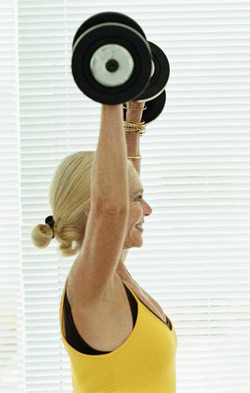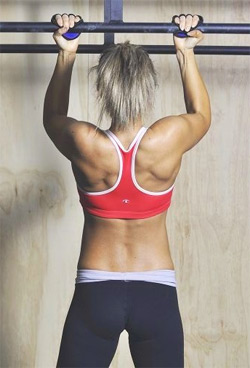|
|
|
 , ,
Font size |
Top 10 Tips to Get the Best from Shoulder Training
 Shoulders
are an important and widely used muscle in the upper body. To build
and maintain them these are the 10 tips. Shoulders
are an important and widely used muscle in the upper body. To build
and maintain them these are the 10 tips.

Start with multi-joint moves first in your workout, when your energy
levels are highest. These moves engage the greatest degree of
muscle mass because two or more sets of joints are working simultaneously.
Overhead presses are the most common shoulder multi-joint exercise, engaging all
three deltoid heads as well as the
triceps and other assisting muscle groups.

Don't fall in love with one type of exercise or the other; opt for
rotation. For e.g. you can choose between seated or standing military press.
When standing, you're better able to generate a bit of thrust through your hips
and knees. Seated presses are considered slightly better for isolating the
target musculature, because it's far more difficult to generate momentum through
your lower body. But you'll sacrifice some weight, some reps, or both as a
result.

Choose free weights over machine weights: Exercise machines were
invented to make exercising easier, more convenient. What started out as good
intention has evolved into a billion dollar industry of fads, gimmicks, quick
fixes. Free
weights incorporate the
stabilizing muscles that enable you to perform the movements you choose to
make and may be more effective in producing overall muscular strength and power
gains. On the other hand, most machines involve moving a weight along a
predetermined path, making it difficult to strengthen the stabilizer muscles.

Go
for Isolation exercises after heavy presses: To target a single
head, for e.g. deltoid, you must train in the particular plane in
which the deltoids is working most actively, targeting the front,
middle, and rear delts. That's done by locking a very slight bend in
your elbows. The degree of bend in your elbows cannot change during
the movement擁t must be locked in one position for the duration of
the set. Train toward the upper end of the muscle-building rep
range, namely choosing a weight in which you can do 10-12 reps per
set, perhaps as low as 8.

 Don't Extend your Elbows during Single-joint Raises: If you start
closing and opening up at the elbows, the triceps are now part of the equation,
reducing the effectiveness of the isolation exercises. Using weights that are
too heavy is often the culprit. Lateral raises and reverse standing cable flyes,
hold a risk of mistake by lifters who extend their elbows to 180 degrees at the
end of the movement, then close them to about 90 degrees as they lower the
weights. Don't Extend your Elbows during Single-joint Raises: If you start
closing and opening up at the elbows, the triceps are now part of the equation,
reducing the effectiveness of the isolation exercises. Using weights that are
too heavy is often the culprit. Lateral raises and reverse standing cable flyes,
hold a risk of mistake by lifters who extend their elbows to 180 degrees at the
end of the movement, then close them to about 90 degrees as they lower the
weights.

Work every body part equally: For e.g. If your deltoids are
fairly evenly developed, you can rotate the order in which you train them
from one workout to the next to ensure balanced development. If you always
do one area last in your workout, over time if will begin to lag behind the
others.

Pay Attention to your Rotator Cuffs: When you train the deltoids and
chest but skip your rotators, the ratio of the strength between the two
muscle groups can become out of balance. This increases your risk of a damaging
rotator-cuff injury. We know that training to avoid injury isn't sexy, but doing
internal and external rotation exercises is important for healthy rotator cuffs,
especially for longtime lifters.

Don't
Skip the Shrugs: Add single-joint shrugs to work the upper
traps. Note, that the middle and lower portions of the trapezius
don't get that degree of activation, and those areas are better
trained on back day.

 Instead of Bicep Curls do
Pull ups: Most pulling exercises pummel the
biceps, but pull-ups reign supreme and trump rowing variations.
Pull-ups, help build bigger arms and a stronger back simultaneously, which
is a glorious win-win. Instead of Bicep Curls do
Pull ups: Most pulling exercises pummel the
biceps, but pull-ups reign supreme and trump rowing variations.
Pull-ups, help build bigger arms and a stronger back simultaneously, which
is a glorious win-win.
 Build
Variety into your Shoulder Training: Consider cycling your shoulder training
after 6-8 weeks, going from light to moderate to heavy, or substituting
different movements into your routine that are alike but slightly different from
the ones you normally do. Substitutions can work the muscle from slightly
different angles, offering greater long-term growth potential. Build
Variety into your Shoulder Training: Consider cycling your shoulder training
after 6-8 weeks, going from light to moderate to heavy, or substituting
different movements into your routine that are alike but slightly different from
the ones you normally do. Substitutions can work the muscle from slightly
different angles, offering greater long-term growth potential.
Remember progression is the Key to Muscle Growth.
Dated 02 March 2015
Related Links
|
|
|
|
|









